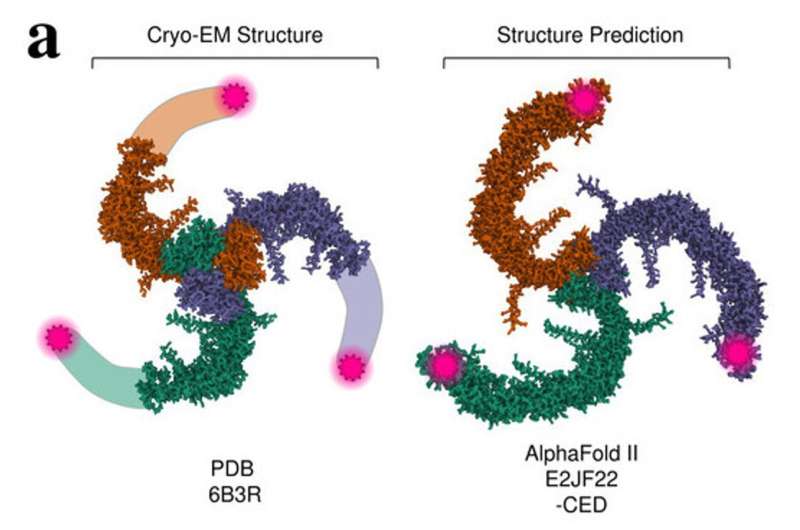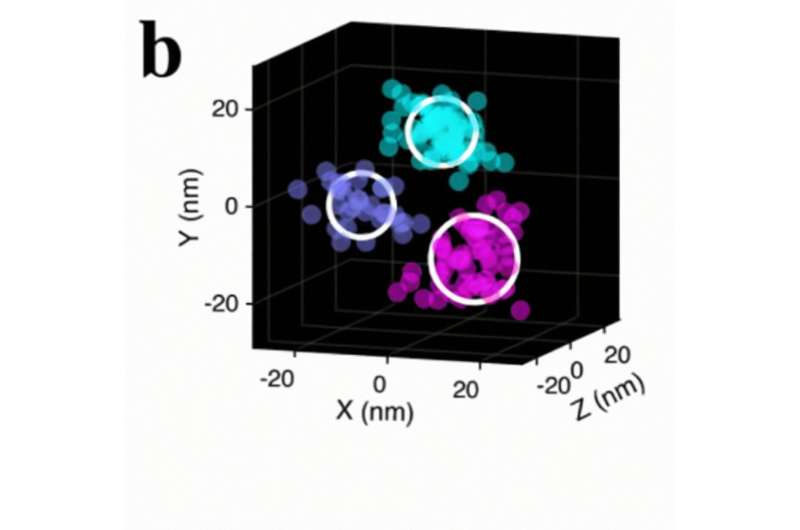This article has been reviewed according to Science X's editorial process and policies. Editors have highlighted the following attributes while ensuring the content's credibility:
fact-checked
peer-reviewed publication
trusted source
proofread
Scientists reveal how sensory protein changes shape with nanometer resolution

The ability to sense mechanical stimuli, like touch or blood pressure, is essential to physiological processes in humans and across the animal kingdom. In a new study, Scripps Research scientists show how the sensory ion channel PIEZO1 changes shape in response to mechanical stimuli, revealing critical information about how this protein functions.
In the study, published in Nature, the researchers characterized the sensor's shape and conformation when embedded in the cell's plasma membrane—its natural working environment.
By tagging different regions of the protein with fluorescent molecules and directly measuring the distances between them, the researchers showed that PIEZO1 has an expanded conformation when situated in the plasma membrane, in contrast to the contracted, cup-like conformation predicted by previous cell-free structural models. This structural finding could lead to future drug discovery applications, like screening for effective medicines related to diseases associated with congenital PIEZO1 defects, such as autosomal recessive congenital lymphatic dysplasia and hereditary xerocytosis.
"Our results show how the cellular environment can shape the structure of PIEZO1 and reveal the basic molecular movements underlying channel activation," says senior author Ardem Patapoutian, Ph.D., professor in the Dorris Neuroscience Center at Scripps Research and a Howard Hughes Medical Institute investigator. Patapoutian received the 2021 Nobel Prize in Physiology or Medicine for discovering PIEZO1 and PIEZO2, the critical receptors that allow cells to respond to mechanical stimuli.
The team wanted to solve an open question: How do these proteins convert a mechanical stimulus into an electrical signal, which is the currency of the nervous system? Answering this would provide insights into what causes PIEZO receptors to malfunction under different conditions.
PIEZO1 is shaped like a three-bladed propeller, and its blades are thought to be the primary sensors of mechanical force, so understanding their structure is critical to understanding how the sensor functions. However, prior models that were based on electron microscopy lacked information on how the tips of these blades are structured. Furthermore, these prior studies were performed on isolated, membrane-free proteins, which means they had a limited ability to predict PIEZO1's shape and movement in the actual cellular environment.
To overcome these limitations, Patapoutian's team used the MINFLUX and iPALM microscopes, which captured nanometer-scale details and allowed the team to visualize individual PIEZO1 molecules in the context of the cell membrane.
"Evaluating PIEZO1 in its cellular context is just one example of the potential of super-resolution microscopy, which could be a transformative research tool for a variety of research programs here at Scripps Research," says co-author Scott Henderson, director of the Scripps Research Core Microscopy Facility and professor in the Department of Integrative Structural and Computational Biology.
The researchers labeled PIEZO1 with fluorescent markers and used the microscopes to image the protein in different situations: at rest, when exposed to a chemical inhibitor, and when activated via stretching of the cell membrane.
They found that when PIEZO1 is not exposed to mechanical stimuli, its blades rest in an expanded conformation. This contrasts with the earlier, membrane-free structural models—without the presence of the cell membrane (which exerts a flattening pressure on PIEZO1's blades), the blades fold into a more cup-like conformation.
"In the cellular environment, PIEZO1 is in a state of mechanical equilibrium where the stresses of the protein on the membrane and the stresses of the membrane on the protein results in a net flattening of the channel," says Eric Mulhall, Ph.D., the study's first author and a postdoctoral fellow in the Patapoutian lab at Scripps Research and the Howard Hughes Medical Institute.

When the researchers exposed PIEZO1 to a toxin from the Chilean rose tarantula that inhibits the receptor's function by relieving the stresses exerted by the membrane, the protein took on the cup-like conformation. Conversely, when they applied a mechanical stimulus by stretching the cell membrane, the protein's blades became even more expanded. This same mechanical stimulus also resulted in electrical activation of the channel. Together these results suggest that the expanded conformation facilitates active transmission of mechanical stimuli.
"The degree of blade expansion seems to correlate with channel activation," says Mulhall. "When the blades are very collapsed, the channel is not active at all, but when they're more expanded or even completely flat, the channel is very active."
The team's single-molecule analysis also revealed that PIEZO1's blades are relatively rigid at their base but more flexible at their ends, which has implications for how sensitive the sensors are to mechanical stimuli. "Having the blades be floppy at their ends might help dampen the background mechanical noise inside a cell," says Mulhall.
Understanding how PIEZO1 changes shape in response to different stimuli could have future applications for screening drugs that might inhibit or activate the sensors.
"Now that we have this model of how the proteins move, we could potentially use this as a readout for modulators of channel activity," says Mulhall. "For example, if you were testing a drug to treat mechanical pain—which is in part mediated by PIEZO channels—you could use this as a platform for knowing whether the drug actually changes the function of the channel."
Next, the researchers want to analyze more positions on the protein to gain information about how the entire protein moves.
Beyond PIEZOs, the study highlights the ability to use fluorescence super-resolution microscopy to analyze the tiniest of movements of proteins in their natural environment. "Now we can start thinking of doing structural biology using a light microscope," says Patapoutian.
As well as Mulhall, Henderson, and Patapoutian, authors of the study "Direct Observation of the Conformational States of PIEZO1," include Anant Gharpure, Adrienne E. Dubin, and Kara L. Marshall of Scripps Research and the Howard Hughes Medical Institute; Rachel M. Lee, Jesse S. Aaron, Michael A. Reiche, and Teng-Leong Chew of the Howard Hughes Medical Institute Janelia Research Campus; and Kathryn R. Spencer of Scripps Research.
More information: Eric M. Mulhall et al, Direct observation of the conformational states of PIEZO1, Nature (2023). DOI: 10.1038/s41586-023-06427-4
Journal information: Nature
Provided by The Scripps Research Institute





















